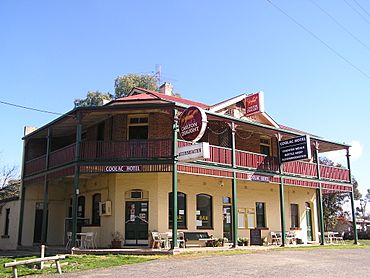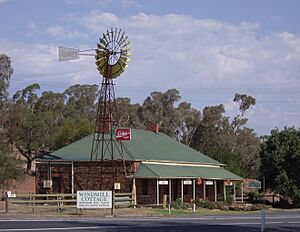Coolac, New South Wales facts for kids
Quick facts for kids CoolacNew South Wales |
|||||||||
|---|---|---|---|---|---|---|---|---|---|

Coolac Hotel
|
|||||||||
| Population | 244 (2021 census) | ||||||||
| Established | 1824 | ||||||||
| Postcode(s) | 2727 | ||||||||
| Elevation | 308 m (1,010 ft) | ||||||||
| Location |
|
||||||||
| LGA(s) | Gundagai Council | ||||||||
| County | Harden | ||||||||
| State electorate(s) | Cootamundra | ||||||||
| Federal Division(s) | Riverina | ||||||||
|
|||||||||
Coolac is a small village located in the Riverina region of New South Wales, Australia. It's part of the Gundagai Council area. In 2021, about 244 people lived in Coolac.
Coolac's Story
The name Coolac comes from the local Aboriginal people. It's linked to a plant that grew a lot in the area. It also means "native bear" in the Aboriginal language.
The Coolac Post Office first opened its doors on 1 June 1870.
For many years, a part of the Hume Highway near Coolac was only two lanes wide. This made it the last two-lane section between Sydney and the Sturt Highway. Plans to make it bigger started in 1986. Building finally began in May 2007, and the new, wider road opened in August 2009.
The Bald Archy Art Prize
The funny Bald Archy art competition started right here in Coolac! It was part of the Coolac Festival of Fun. This competition is a playful version of the more serious Archibald Prize.
Today, the Bald Archy Prize is based at the Museum of the Riverina in Wagga Wagga. It also travels to big cities like Sydney and Melbourne for people to see. The most interesting part? The official judge is a cockatoo named Maude! She's the one who picks the winning artworks each year.
Coolac's Special Rocks
About 48 kilometers (30 miles) northeast of Coolac is a very important geological site. It's one of the best places in Australia to see something called an "ophiolite."
An ophiolite is a special group of rocks. These rocks were once part of the oceanic crust and the Earth's mantle. Normally, these deep rocks are not seen on the surface. But here in Coolac, they are! The site is about 130 hectares (320 acres) big. The rocks here, especially one called Coolac Serpentinite, help scientists understand how eastern Australia's land has changed over millions of years.



